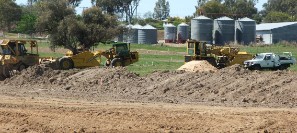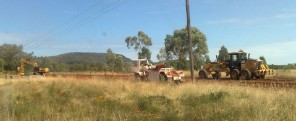

It all comes back to $ per metre
How do you know which machine, or combination of machines, will construct your project satisfactorily for the least cost?
There are three broad types of earthmoving machine, epitomised by the Bulldozer, the Excavator and the Scraper. There is some overlap in capability, and on small jobs, each type can manage to do just about any job on its own. But they were originally invented and developed, and exist as new machines available for purchase to this day, because of their particular capabilities.
The Bulldozer is the cheapest bulk shifter of soil and rock available, over short distances up to around 30 metres. Its "bucket", the blade, has only one side and uses the ground for its bottom. It fills in a few seconds and can empty just as quickly, but it can only push its load around on the ground. It has excellent traction, and is very robust, able to tackle many and varied difficult jobs, from rock to mud and everything in between. For small farm dams, contour bank construction or alteration, timber and rock clearing and rough site levelling, it is often the first choice. Bulldozers of all sizes are commonly available and therefore competitively priced for hire. However the bulldozer is unable to properly compact the structures it builds, the traction ability it has means its weight is spread widely, and generates a low point load. If construction grade compaction is required, a grader and roller, with a water cart if moisture content is too low, will be needed to finish the job. And the distance the soil must be moved is critical. A bulldozer rapidly loses its cost advantage as push distance increases. A bulldozer can move the first "push" for as little as $0.50 per cubic metre, but by the third "push" (in the same line) it can be over $1.20 per metre, and more than 6 pushes in the one line can blow out to $5 per metre. Careful planning is required to ensure a bulldozer stays within its cost competetive envelope. A scraper may cost $1.20 per metre on its minimum cycle distance, but you can triple the haul length from 130 to 400 metres for almost no difference per cubic metre of load.
Excavators are extremely flexible machines, able to "bench" their way in to jobs a scraper could not access, and a Dozer would find difficult. But they are slow to move large quantities, and depend on extra machines like tip trucks where access is good, and dump trucks where access is limited, to move substantial quantities any distance greater than their "reach", generally less than 20 metres. When dependant on trucks for haulage, the excavator idle time can become a prohibitive cost, and must be factored in to per metre calculations, as well as the cost of the trucks, and a grader or bulldozer if anything other than a stockpile is being built at the other end.
Scrapers come in two basic forms, and three sizes(11, 21 and 31 cubic yards, with minor variations due to type - and the Cat 651 and 657 are 44 cubic yards, in a size of their own). The two forms are open bowl, which either requires a bulldozer to push-load it in the case of single engine machines, or another scraper to couple with in the case of twinpowers, for fast efficient loading, and elevating, where a system of steel flights on roller chains feeds the soil building up in front of the ground engaging blade, into the bowl.
Open Bowl scrapers are cheaper to own and maintain, and single powers are likewise cheaper than twinpowers. Open bowl scrapers generally produce a rough lumpy load of broken up sheets of soil, depending in material type, and elevators produce a fractured, smaller clod sized load which tends to spread and compact better.
Elevating scrapers are stand-alone machines able to work unaided, open bowl machines tend to be part of a fleet of machinery typically seen on very large projects. All scrapers are fast and highly manouverable, and can handle steep climbs and very rough terrain. Most (except single power open bowls) have the power to load themselves, so when it comes to travelling they are overpowered, and can quickly reach speeds of 50km per hour. There is a time penalty to complete loading compared to a bulldozer, but once loaded they will deliver soil or rock faster and cheaper than anything else, out to about 5km of distance. The scraper needs to "drive over" its load when loading and unloading, so cannot push a bank out over an edge like a bulldozer can. Because a scraper is wheeled rather than tracked, it cannot operate well in wet boggy conditions, but its reduced weight spread means it generates high point loads on the soil it is spreading, and provided moisture content is in the necessary range (sometimes requiring a water truck) and the operator pays attention to what he is doing, very high campaction of material is possible. This introduces one of the limits for scrapers - they can cause irreparable damage to farm soil structure when land levelling fields in damp conditions, and a laser bucket pulled by a tracked tractor becomes the machine of choice, unless the soil is very dry, or the cuts are greater than 20cm deep. When a laser bucket has to stop loading to rip the cuts, it becomes quite inefficient compared to an elevating scraper with ripper teeth - it cannot rip deeper than one cut, and immediately re-compacts the material when it starts to load again.
So how do you choose which machine? Make sure you know (at least roughly) how many cubic metres you have to move, and how far. It is only simple maths, even pacing the job out is better than guessing. Get prices to compare in cubic metre terms. If the job is small (less than $5,000), get any machine that is working in the area, float costs can be $1,000 or more, and will cancel out any efficiency savings. Be aware of soil volumes - generally contractors work in "compacted" cubic metres, but what degree of compaction will they achieve, and how important is it? If you are building a house pad, it must be done properly, and should be tested. Saving $4,000 on the pad of a $200,000 house is false economy. Other soil volumes are "bank state" which is the volume of soil as it naturally occurs (say measuring a cut, like a swimming pool excavation), and "loose" which is what every machine moves soil as. The capacity of an excavator bucket, a bulldozer blade, or a scraper bowl is fixed and will always be "loose" metres, but the difference between sand and wet black clay is large - sand does not compact much, so the difference between bank state metres before the borrow is disturbed, loose metres in the "bucket" and compacted metres after completion may only be 10%. For a bank state cubic metre of wet black clay, you may only fit 0.6 cubic metres per loose cubic metre in the "bucket", and 0.4 cubic metres in the job by the time it is compacted, dramatically altering your costs.
Generally, if the job involves moving soil or rock more than 30metres on average, you should at least get a price for a scraper to do it (this won't cost you anything, and may save you a lot). Jobs such as larger dam construction, gully filling or reshaping where soil must be brought in more than 30m, house or shed pads where the soil or rock can be sourced locally, but must be moved between 30m and 5km (more than 5 km means trucks and excavators become cheaper due to the speed of the trucks, as long as there is a road for them to travel on) and road construction where clay, rock or gravel is available on farm, will generally be completed cheaper and better by an elevating scraper.